![]()
![]()
![]()
Use LEFT and RIGHT arrow keys to navigate between flashcards;
Use UP and DOWN arrow keys to flip the card;
H to show hint;
A reads text to speech;
117 Cards in this Set
- Front
- Back
|
mitosis |
1. process used by cells to accurately duplicate and faithfully segregate chromosomes during cell division 2. divided into 6 phases 3. phases are in continuum accurate separation of duplicated chromosomes; involves a molecular machine comprised of dynamic microtubules and microtubule-associated motors |
|
|
6 phases of mitosis |
1. prophase 2. prometaphase 3. metaphase 4. anaphase 5. telophase 6. interphase |
|
|
interphase |
1. chromosome duplication and cohesion 2. centrosome duplication 3. comes after M phase 4. includes G1, S and G2 |
|
|
prophase |
1. break down of the interphase microtubule display and its replacement by mitotic asters 2. mitotic aster separation 3. chromosome condensation 4. kinetochore assembly 5. centromere duplication 6. spindle assembly 7. nuclear envelope breakdown |
|
|
prometaphase |
1. nuclear envelope breakdown 2. chromosome recaptured 3. chromosome bi-oriented and brought to spindle equator 4. chromosomes capture MTs at ends or sides |
|
|
metaphase |
1. chromosomes aligned at the metaphase plate 2. spindle assembly checkpoint system monitors unattached kinetochores and delays anaphase until all chromosomes are attached |
|
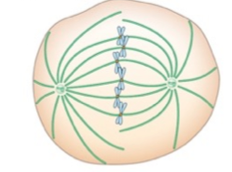
|
metaphase |
|
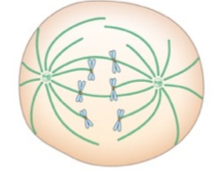
|
prometaphase |
|

|
prophase |
|
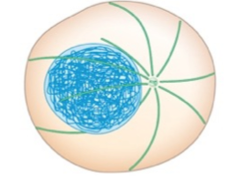
|
interphase |
|
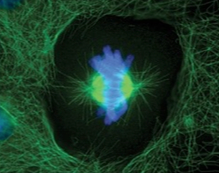
|
metaphase |
|
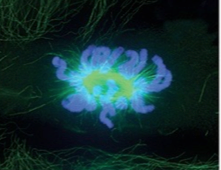
|
prometaphase |
|
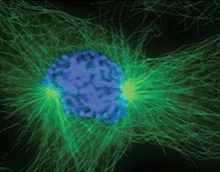
|
prophase |
|
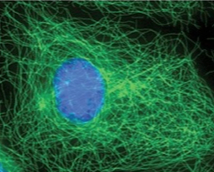
|
interphase |
|
|
anaphase |
1. duplicated chromosomes separate and move toward spindle poles APC/C activated 2. cohesins degraded 3. Anaphase A & Anaphase B sister chromatid separation |
|
|
Anaphase A |
chromosome movement to poles 1. disassembly of MTs from (+) ends rapidly induces chromosome movement to poles 2. Kinesin-13 is needed in Drosophila for phase A |
|
|
Anaphase B |
spindle pole separation 1. bipolar kinesin-5 slide polar MTs apart 2. dynein at cortex pulls astral MTs 3. helps to separate the spindle poles |
|
|
telophase |
1. nuclear envelope reassembly 2. assembly of contractile ring 3. mitotic spindle disassembly 4. nuclear envelope re-formation 5. cytokinesis
|
|
|
cytokinesis |
1. reformation of interphase microtubule array 2. contractile ring forms cleavage furrow |
|

|
cytokinesis |
|
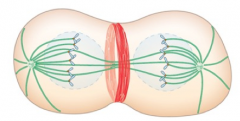
|
telophase |
|
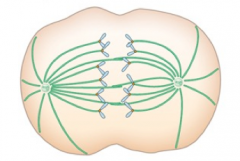
|
anaphase |
|

|
cytokinesis |
|
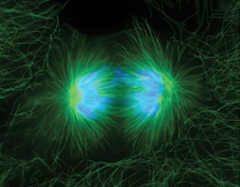
|
telophase |
|
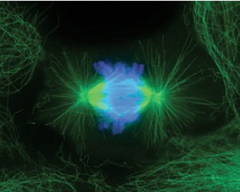
|
anaphase |
|
|
centrosome duplication |
occurs early during mitosis |
|
|
3 classes of MTs in the mitotic spindle |
1. polar MTs 2. astral MTs 3. Kinetochore MTs |
|
|
Kinetochore MTs |
1. class of MTs in the mitotic spindle 2. extend form spindle pole to kinetochore on chromosome 3. attach to chromosomes |
|
|
Astral MTs |
1. class of MTs in the mitotic spindle 2. extend from the spindle pole to the cell cortex |
|
|
polar MTs |
1. class of MTs in the mitotic spindle 2. extend from spindle pole toward the opposite pole 3. interact with one another in anti-parallel manner 4. overlap in the middle of the spindle |
|

|
astral MT |
|
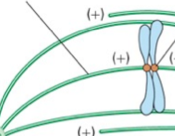
|
kinetochore MT |
|
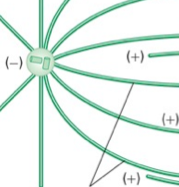
|
polar MTs |
|
|
kinetochores |
1. capture microtubules 2. two kinetochores (one on each) become attached to opposite spindle poles (bi-oriented) 3. allows the chromosome to congress to the middle of the spindle |
|
|
centromere sequences |
1. on chromosome 2. form constricted regions on condensed chromatin 3. lie where the kinetochore assembles 4. (+) ends of MTs are bound by the kinetochore |
|
|
(+) ends of MTs |
bound by the kinetochore |
|
|
dynein activity |
allows chromosomes to move to pole |
|
|
how do chromosomes move to the pole? |
via dynein activity |
|
|
congression |
balance of assembly, disassembly, and motor protein activity |
|
|
chromosome capture |
1. during prometaphase, chromosomes capture MTs at sides or ends 2. chormosome move to pole via dyenin 3. MTs from opposite pole are captured by the chromosome |
|
|
cell cycle |
1. ordered series of macromolecular events 2. leads to cell division and production of two daughter cells 3. each daughter cell has the same parental chromosomal number
|
|
|
cell cycle phases |
1. S phase 2. M phase 3. G1 4. G2 5. G0 |
|
|
S phase |
chromosomes are duplicated DNA is actively replicated |
|
|
M phase |
mitosis where daughter chromosomes are distributed to daughter cells |
|
|
G1 |
1. gap phase 2. cells grow and synthesize RNAs and proteins needed for DNA synthesis |
|
|
G2 |
1. gap phase 2. preceed M phase |
|
|
G0 |
1. gap phase 2. special phase exists in vertebrate cells 3. extended quiescent state |
|
|
draw cell cycle |

|
|
|
CDKs |
1. cyclin dependent kinases 2. control passage through the cell cycle 3. kinase activity requires association with cyclins 4. activity is determined by the particular bound cyclin 5. initiate every aspect of each cell cycle stage by phosphorylating many different target proteins |
|
|
cyclins |
1. proteins whose levels fluctuate during the cell cycle 2. binds and activate CDKs 3. are only present during the particular cell cycle when they function/promote 4. regulate the particular stage and prepare the cell for the next stage 5. propel the cell cycle forward 6. oscillate during the cell cycle (positive/negative feedback loops) |
|
|
what controls entry into S phase |
G1 and G1/S cyclin-CDKs |
|
|
G1 and G1/S cyclin-CDKs |
controls entry into S phase |
|
|
S phase cyclin-CDKs |
required for DNA replication initiation |
|
|
what is required for DNA replication initiation |
S phase cyclin-CDKs |
|
|
mitotic cyclin-CDKs |
activated at end of S phase that initiate prophase |
|
|
what is activated at the end of S phase to initiate prophase? |
mitotic cyclin-CDKs |
|
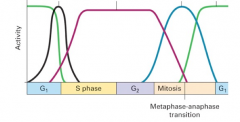
green |
APC/C activity |
|
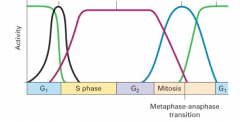
black |
G1/S phase CDKs |
|
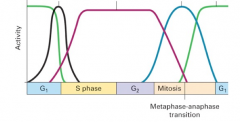
red |
S phase CDKs |
|

blue |
mitotic CDKs |
|
|
G1/S phase CDKs peak/minimums? |
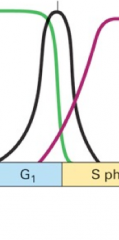
|
|
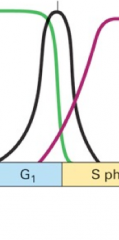
|
G1/S phase CDK |
|
|
when is APC/C activity present? |
1. minimums: beginning of S phase AND middle of mitosis 2. peak: end of mitosis and plateus into end of G1
|
|
|
when is S phase CDK activity? |
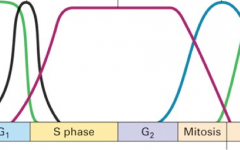
1. minimum: end of G1 AND middle of mitosis 2. peak: plateus between S phase, G2 3. starts dropping at the beginning of mitosis |
|
|
budding yeast |
1. used to perform temperature-sensitive mutant screens 2. morphology provided a tool to determine when cell cycle arrest occurred |
|
|
fission yeast |
1. used to perform temp-sensitive mutant screens 2. morphology provided a tool to determine when cell cycle arrest occured |
|
|
two types of yeast |
1. budding yeast 2. fission yeast |
|
|
complementation cloning |
via yeast transformation |
|
|
yeast transformation |
1. used to rescue mutant phenotype 2. allow complementation cloning of the cdc mutant genes |
|
|
frog oocyte |
1. used to identify cyclins and cyclin-dependent kinase activities 2. extracts could be induced to go through cell cycles by adding sperm nuclei |
|
|
what was the purpose of tissue culture cells |
1. used to test functions of cell cycle proteins 2. especially useful for studying function in cancer cells |
|
|
cyclin-CDK activity |
1. activity cycled during rapid cell cycles 2. cyclin proteins comes and goes, message must persist 3. removing all mRNA by brief RNase treatment blocks cells cycle effect 4. adding cyclin mRNA restored cell cycles |
|
|
cyclin mRNA |
1. addition to cells restore cell cycle 2. contains destruction box |
|
|
mutant cyclin mRNA |
lacks "destruction box"
|
|
|
destruction box |
1. needed for degradation at the end of cell cycle 2. degradation caused by mitotic arrest in early mitosis |
|
|
G1-S phase transition |
transition through the G1-S phase commits the cell to go completely through the cell cycle |
|
|
G1-S phase cyclins |
1. regulated transcriptionally 2. synthesized via feedback production 3. induce different actions based on type of cell 4. promote S-phase 5. inhibits APC/C 6. cause degradation of CDK inhibitors (CKIs) --> triggers DNA replication |
|
|
cyclin3 |
regulated by nutrient availability |
|
|
cyclin D |
regulated by growth factors |
|
|
control of G1-S phase transition (metazoans) |
1. G1-S phase cyclins are synthesized by feedback production 2. induce S phase 3. centrosome duplication |
|
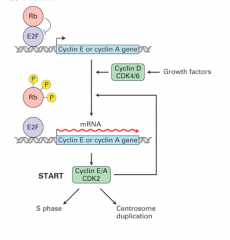
|
control of G1-S phase transition (metazoans) |
|
|
control of G1-S phase transition (yeast) |
1. G1-S phase cyclins are synthesized by feedback production 2. induce budding 3. induce S phase 4. induce spindle pole body duplication |
|
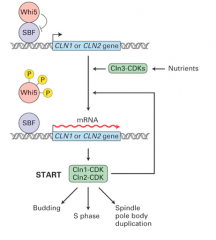
|
control of G1-S phase transition (yeast) |
|
|
APC/C activity |
1. induces S-phae cyclin degradation 2. inhibited by G1-S phase cyclins |
|
|
what degrades S-phase cyclin? |
APC/C activity |
|
|
what inhibits APC/C activity? |
G1-S phase cyclins |
|
|
ORC |
1. origin recognition complex 2. binds to specific DNA sequences |
|
|
low S-phase CDK activity |
leads to helicase, Cdc6, and Cdt1 binding |
|
|
high S-phase CDK activity |
1. leads to helicase, Cdc6, and Cdt1 phosphorylation 2. causes the exchange of ORC and helicase activators |
|
|
S-phase CDK |
1. phosphorylates helicase --> 2. prevents additional binding to origin of replication --> 3. ensuring only one round of DNA synthesis |
|
|
CPC |
1. chromosome passenger complex 2. associated with inner kinetochore plates 3. keeps microtubule attachments weak via kinase activitiy in Aurora B |
|
|
Aurora B |
1. phosphorylates critical kinetochore proteins 2. associated with CPC 3. substrates are pulled away from the kinase when tension is generated when the chromosome is bi-oriented 4. w/out phosphorylation, the chromosome-kinetochore attachements becomes stable |
|
|
spindle poles |
1. pull shortened kinetochore microtubules during anaphase to separate chromosomes (anaphase A) 2. pushed by bipolar kinesin-5 3. move toward the (+) end of polar microtubules (anaphase B) |
|
|
spindle separation |
facilitate by cortically located dynein pulling on astral microtubules |
|
|
mitotic spindle |
1. has ability to self-assemble in the absense of MTOCs 2. redundant mechanisms contribute to the fidelity of mitosis |
|
|
contractile ring |
1. actin-myosin based 2. position determined by position of the spindle 3. contracts to pinch the cell in two during cytokinesis |
|
|
cell division in plants |
delivery of membranes by microtubules to assemble the phragmoplast
|
|
|
phragmoplast |
1. becomes the plasma membrane of the two daughter cells 2. cell division in plants |
|
|
eurkaryotic cell cycle |
divided into four phases: G1, S, G2 and M |
|
|
G1 phase |
1. period between mitosis and the initiation of nuclear DNA replication 2. cells commit to a new cell division at START point |
|
|
S phase |
period of nuclear DNA replication |
|
|
G2 phase |
period between the completion of nuclear DNA replication and mitosis |
|
|
M phase |
mitosis |
|
|
START point |
1. in G1 2. cells commit to a new cell division at START point |
|
|
cyclin-CDK complexes |
1. composed of a regulatory cyclin subunit and CDK subunit 2. drive progression of cell through the cell cycle |
|
|
what drives the oscillations in the cell cycle |
positive and negative feedback loops |
|
|
surveillance mechanisms |
1. called checkpoints 2. guarantee that each cell cycle step is completed correctly before the next on is initiated |
|
|
what are used to study isolation of key cell cycle factors and mutants? |
budding and fission yeast |
|
|
what are useful to provide biochemical studies of cell cycles |
frog eggs |
|
|
what are used to study interplay between cell division and developmental programs in multicellular organisms |
fruit flies |
|
|
what are used to study the properties of the mammalian cell cycle |
human tissue culture cells |
|
|
protein degradation |
1. key mechanisms for restriction cyclins to appropriate cell cycle stage 2. mediated by ubiquitin-proteasome system and ubiquitin ligases APC/C and SCF 3. |
|
|
CKIs |
1. CDK inhibitors 2. inhibit CDK activity by directly binding to the cyclin-CDK complex |
|
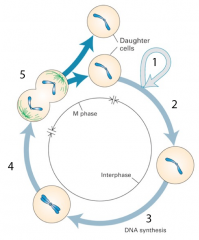
|
1. G0 2. G1 3. S 4. G2 5. M |
|

|
1. G1/S phase CDKs 2. S phase CDKs 3. Mitotic CDKs 4. APC/C activity |
|
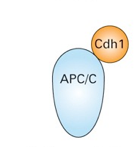
|
1. exit from mitosis and G1 2. S phase, mitotic cyclins unstable 3. results from Cdc 14 phosphatase |
|
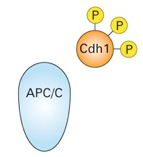
|
1. S phase and mitosis 2. S phase, mitotic cyclins stable 3. G1/S phase CDKs |

